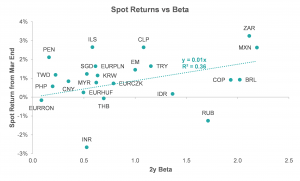Resumo do Relatório
FX Dashboard: Leaders and Laggards in EM FX as US Yields Retreat from the Peak
After consistently drifting lower this month, the dollar took a breather today as the dollar index (DXY) was flat for the day. Similar to the dollar, EM currencies were also flat on average. Even within EM, there were few outliers as most currencies were within 0.3% of their respective yesterday’s closes. Although there was little dispersion within EM today, for the month as a whole the picture is different.
The US 10y yield peaked at 1.75% at the end of March and has dropped to 1.60% since then even as the incoming activity and inflation data in the US have surprised on the upside, indicating that the reflationary scenario is priced in. The dollar has weakened by 2.3% this month on a combination of the drop in US long-end yields and vaccine supply constraints in Europe finally getting resolved.
With the dollar weakening, EM currencies have appreciated 1.5% on average. As EM currencies have around from their weak performance in Q1, there has been a fair amount of differentiation among EM countries. To highlight this differentiation, we plot the performance of EM currencies against their respective betas in the chart below.
The currencies that stand out as underperformers are:
- The Indian rupee (INR): Indian equities and the currency have taken a hit after a sharp ramp-up in coronavirus cases and hospitalizations, rekindling economic worries. Earlier this year, it appeared that India had managed the pandemic well. However, the picture changed dramatically over the past month as the country now has the highest daily cases in the world. Worsening the picture is the upcoming state election in West Bengal, which is currently the singular focus for Prime Minister Modi.
- The Russian ruble (RUB): The ruble has been lagging other currencies and oil prices in anticipation of US sanctions. As we discussed in our trade recommendation note yesterday, with the sanctions now behind we expect the currency to begin to catch up to its peers although risks at the Ukraine border remain.
- The Indonesian rupiah (IDR): The rupiah has taken a hit from the uncertainty created by President Joko Widodo’s announcement of a potential change to the central bank’s mandate to include economic goals. Given the importance of bond inflows, we would expect the legislation to be diluted or postponed. Moreover, Bank Indonesia lowered their economic growth forecasts but held rates steady with currency stability in mind. Instead, they opted for macroprudential measures to spur lending. With IDR already reflecting the negative scenario, we have recommended a trade to be long IDR vs the Singapore dollar (SGD).
The currencies that have outperformed in the rally are:
- The Israeli shekel (ILS): After reaching its strongest nominal level in over 25 years in January, the shekel weakened as the Bank of Israel embarked on a massive intervention program and the inconclusive fourth election in two years added to the weakness. In a recent note, we argued that if the currency continues to depreciate, we would be looking for an entry point for a long recommendation on the back of the expected bounce in growth and a wide current account surplus. Some of the underperformance appears to have reversed already.
- The South African rand (ZAR): The rand has been the best performer among EM currencies over the past year, helped by the rally in commodities supporting its current account and a hawkish central bank. As mentioned above, we have recommended a long RUB vs short ZAR trade as these supportive developments are priced in the currency in our view.
- The Chilean peso (CLP): The dollar weakening has once again propelled copper price close to its decade-high levels, supporting the peso. Additionally, despite the recent rise in coronavirus cases, the country leads the region with its rapid pace of vaccinations, setting up the conditions for a strong economic rebound.
- The Peruvian sol (PEN): The currency was expected to be volatile going into the presidential election as has been the case. As we head to the second round in June between an extreme left-wing and a right-wing candidate, the volatility will likely pick up further as we discussed in a recent note, which may present an opportunity along the way.

Data Source: Refinitiv; Note: EM refers to an index created from equally weighted spot returns for 22 EM currencies
Best Longs / Best Shorts
- From our list of underperformers in the attached FX Dashboard, we removed the Israeli shekel (ILS) as its z-score receded.
- The list now consists of the Romanian leu against the euro (EURRON) and the Thai baht (THB).
- Our list of outperformers is unchanged with the South African rand (ZAR) and the Chilean peso (CLP) on it, in line with the discussion above regarding currencies that have outperformed.
Best Crosses
- Our list of preferred relative-value trades shrunk to Short ZAR vs Long THB or Indian rupee (INR) or RUB or the Indonesian rupiah (IDR).
- The 3m expected returns for these pairs have dropped but are still high in the range of 9.5-10.0% (not annualized), assuming mean reversion.
Aviso legal
DISCLAIMER: Este Relatório de Análise foi elaborado e distribuído pelo Analista, signatário unicamente para uso do destinatário original, de acordo com todas as exigências previstas na Resolução CVM nº 20 de 26 de fevereiro de 2021 e tem como objetivo fornecer informações que possam auxiliar o investidor a tomar sua própria decisão de investimento, não constituindo qualquer tipo de oferta ou solicitação de compra e/ou venda de qualquer produto. As decisões de investimentos e estratégias financeiras devem ser realizadas pelo próprio leitor, os Analistas, ou a OHMRESEARCH não se responsabilizam por elas. Os produtos apresentados neste relatório podem não ser adequados para todos os tipos de investidores. Antes de qualquer decisão de investimentos, os investidores deverão realizar o processo de suitability no agente de distribuição de sua confiança e confirmar se os produtos apresentados são indicados para o seu perfil de investidor. A rentabilidade de produtos financeiros pode apresentar variações e seu preço ou valor pode aumentar ou diminuir num curto espaço de tempo. Os desempenhos anteriores não são necessariamente indicativos de resultados futuros. A rentabilidade divulgada não é líquida de impostos. As informações presentes neste material são baseadas em simulações e os resultados reais poderão ser significativamente diferentes.
O(s) signatário(s) deste relatório declara(m) que as recomendações refletem única e exclusivamente suas análises e opiniões pessoais, que foram produzidas de forma totalmente independente e que a OHMRESEARCH não tem qualquer gerência sobre este conteúdo. As opiniões aqui expressas estão sujeitas a modificações sem aviso prévio em decorrência de alterações nas condições de mercado. O Analista responsável pelo conteúdo deste relatório e pelo cumprimento da Resolução CVM nº 20/21 está indicado acima, sendo que, caso constem a indicação de mais um analista no relatório, o responsável será o primeiro analista credenciado a ser mencionado no relatório. Os analistas cadastrados na OHMRESEARCH estão obrigados ao cumprimento de todas as regras previstas no Código de Conduta da APIMEC para o Analista de Valores Mobiliários e no Manual de Controles Internos para Elaboração e Publicação de Relatórios da OHMRESEARCH. De acordo com o art. 21 da Resolução CVM nº 20/21 caso o Analista esteja em situação que possa afetar a imparcialidade do relatório ou que configure ou possa configurar conflito de interesse, este fato deverá estar explicitado no campo “Conflitos de Interesse” deste relatório.
O conteúdo deste relatório é de propriedade única do Analista signatário e não pode ser copiado, reproduzido ou distribuído, no todo ou em parte, a terceiros, sem prévia e expressa autorização deste Analista. Todas as informações utilizadas neste documento foram redigidas com base em informações públicas, de fontes consideradas fidedignas. Embora tenham sido tomadas todas as medidas razoáveis para assegurar que as informações aqui contidas não são incertas ou equívocas no momento de sua publicação, o Analista não responde pela veracidade das informações do conteúdo.
Para maiores informações, pode-se ler a Resolução CVM nº 20/21 e o Código de Conduta da APIMEC para o Analista de Valores Mobiliários. Este relatório é destinado exclusivamente ao assinante da OHMRESEARCH que o contratou. A sua reprodução ou distribuição não autorizada, sob qualquer forma, no todo ou em parte, implicará em sanções cíveis e criminais cabíveis, incluindo a obrigação de reparação de todas as perdas e danos causados, nos termos da Lei nº 9.610/98 e de outras aplicáveis.





